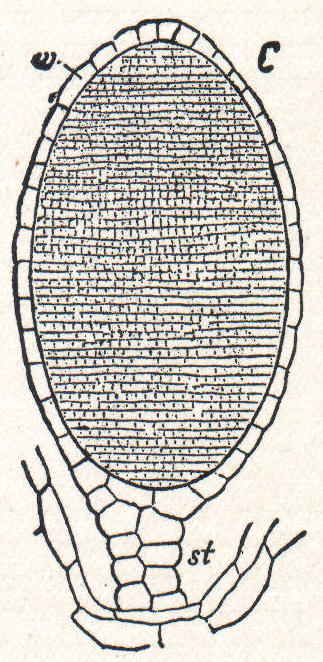antheridium on:
[Wikipedia]
[Google]
[Amazon]
 An antheridium is a haploid structure or organ producing and containing male gametes (called ''antherozoids'' or
An antheridium is a haploid structure or organ producing and containing male gametes (called ''antherozoids'' or
File:Chara contraria oogon.jpeg, Oogonium (larger) and antheridium (with red centre) of the alga '' Chara'', produced on the stem of a plant
File:Hypnum cupressiforme perichaetialblaetter.jpeg,
File:Antheridia polytrichum.jpg, "Moss flowers": each shoot has a cluster of antheridia, i.e., an androecium.
File:Marchantia polymorpha male.jpg, Sperm of the liverwort ''
''Fern''. Encyclopedia of Earth. National council for Science and the Environment
Washington, DC {{Botany Plant anatomy Plant reproduction he:מורפולוגיה של הצמח - מונחים#איברים בצמחים פרימיטיביים
 An antheridium is a haploid structure or organ producing and containing male gametes (called ''antherozoids'' or
An antheridium is a haploid structure or organ producing and containing male gametes (called ''antherozoids'' or sperm
Sperm is the male reproductive cell, or gamete, in anisogamous forms of sexual reproduction (forms in which there is a larger, female reproductive cell and a smaller, male one). Animals produce motile sperm with a tail known as a flagellum, wh ...
). The plural form is antheridia, and a structure containing one or more antheridia is called an androecium. Androecium is also the collective term for the stamens of flowering plants.
Antheridia are present in the gametophyte phase of cryptogam
A cryptogam (scientific name Cryptogamae) is a plant (in the wide sense of the word) or a plant-like organism that reproduces by spores, without flowers or seeds. The name ''Cryptogamae'' () means "hidden reproduction", referring to the fact ...
s like bryophyte
The Bryophyta s.l. are a proposed taxonomic division containing three groups of non-vascular land plants (embryophytes): the liverworts, hornworts and mosses. Bryophyta s.s. consists of the mosses only. They are characteristically limited in s ...
s and ferns. Many alga
Algae (; singular alga ) is an informal term for a large and diverse group of photosynthetic eukaryotic organisms. It is a polyphyletic grouping that includes species from multiple distinct clades. Included organisms range from unicellular micr ...
e and some fungi, for example ascomycete
Ascomycota is a phylum of the kingdom Fungi that, together with the Basidiomycota, forms the subkingdom Dikarya. Its members are commonly known as the sac fungi or ascomycetes. It is the largest phylum of Fungi, with over 64,000 species. The defi ...
s and water mould
Oomycota forms a distinct phylogenetic lineage of fungus-like eukaryotic microorganisms, called oomycetes (). They are filamentous and heterotrophic, and can reproduce both sexually and asexually. Sexual reproduction of an oospore is the resul ...
s, also have antheridia during their reproductive
The reproductive system of an organism, also known as the genital system, is the biological system made up of all the anatomical organs involved in sexual reproduction. Many non-living substances such as fluids, hormones, and pheromones are al ...
stages. In gymnosperms and angiosperm
Flowering plants are plants that bear flowers and fruits, and form the clade Angiospermae (), commonly called angiosperms. The term "angiosperm" is derived from the Greek words ('container, vessel') and ('seed'), and refers to those plants th ...
s, the male gametophytes have been reduced to pollen grains
Pollen is a powdery substance produced by seed plants. It consists of pollen grains (highly reduced microgametophytes), which produce male gametes (sperm cells). Pollen grains have a hard coat made of sporopollenin that protects the gametoph ...
and in most of these the antheridia have been reduced to a single generative cell within the pollen grain. During pollination, this generative cell divides and gives rise to sperm cells.
The female counterpart to the antheridium in cryptogams is the archegonium
An archegonium (pl: archegonia), from the ancient Greek ''ἀρχή'' ("beginning") and ''γόνος'' ("offspring"), is a multicellular structure or organ of the gametophyte phase of certain plants, producing and containing the ovum or female ga ...
, and in flowering plants is the gynoecium.
An antheridium typically consists of sterile cell
Cell most often refers to:
* Cell (biology), the functional basic unit of life
Cell may also refer to:
Locations
* Monastic cell, a small room, hut, or cave in which a religious recluse lives, alternatively the small precursor of a monastery w ...
s and spermatogenous tissue. The sterile cells may form a central support structure or surround the spermatogenous tissue as a protective jacket. The spermatogenous cells give rise to spermatids via mitotic cell division
Cell division is the process by which a parent cell divides into two daughter cells. Cell division usually occurs as part of a larger cell cycle in which the cell grows and replicates its chromosome(s) before dividing. In eukaryotes, there a ...
. In some bryophyte
The Bryophyta s.l. are a proposed taxonomic division containing three groups of non-vascular land plants (embryophytes): the liverworts, hornworts and mosses. Bryophyta s.s. consists of the mosses only. They are characteristically limited in s ...
s, the antheridium is borne on an '' antheridiophore'', a stalk-like structure that carries the antheridium at its apex.
Gallery
Marchantia polymorpha
''Marchantia polymorpha'' is a species of large thalloid liverwort in the class Marchantiopsida. ''M. polymorpha'' is highly variable in appearance and contains several subspecies. This species is dioicous, having separate male and female plants ...
'' are produced on the upper surface of antheridiophores.
File:Marchantia antheridium mosbo6.jpg, Cross-sectional micrograph of the antheridial head of ''Marchantia'' sp., showing antheridia containing spermatogenous tissue.
File:Equisetum Antheridia.jpg, Antheridium (indicated by the red box) of an '' Equisetum'' sp.
See also
*Hornwort
Hornworts are a group of non-vascular Embryophytes (land plants) constituting the division Anthocerotophyta (). The common name refers to the elongated horn-like structure, which is the sporophyte. As in mosses and liverworts, hornworts have a ...
s have antheridia, in some cases arranged within androecia.
* Microsporangia produce spores that give rise to male gametophytes.
References
Further reading
*C.Michael Hogan. 2010''Fern''. Encyclopedia of Earth. National council for Science and the Environment
Washington, DC {{Botany Plant anatomy Plant reproduction he:מורפולוגיה של הצמח - מונחים#איברים בצמחים פרימיטיביים